介绍
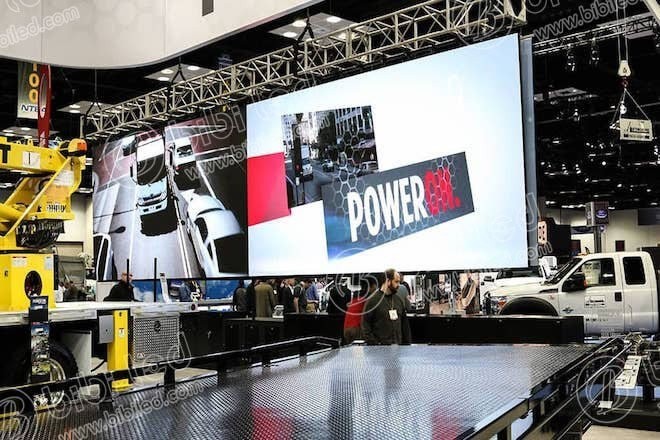
当你走进展厅,你是否被那些令人眼花缭乱的 LED显示屏?
它们不仅传递着丰富的信息,更以其独特的魅力让每一次展会都成为视觉与心灵的盛宴。但面对种类繁多的LED显示屏,如何选择最适合自己展厅的LED显示屏呢?
别担心,这篇文章就是你的救星!我们将带您深入了解展厅环境对显示屏的特殊需求,揭示不同 LED 显示屏的特点和优势,并通过实际案例和成本效益分析为您提供简明的购买指南。
无论您是展厅新手,还是资深操作人员,您都可以在这里找到适合您的答案,让您的展厅展示更加丰富多彩!
接下来,让我们一起踏上这段寻找完美LED显示屏的旅程吧!
1、展厅环境分析
1). 光照条件:亮度是关键
- 自然光和人工照明的影响
试想一下,当你走进一个展厅,如果外面阳光明媚,但显示屏却很暗,是不是要凑近才能看清楚?这就是自然光对显示屏亮度的影响。
同样,如果展厅里的灯光明亮,显示屏也必须足够明亮,才能一眼看清楚,所以在选择显示屏的时候,要看显示屏是否够亮,在强光下是否能保持清晰。
- 高亮度的必要性
高亮度 显示屏犹如一盏明亮的灯,在明亮的环境下依然能照亮您的视线,不仅让您在阳光充足的展厅中轻松阅读内容,还能减少反光和眩光,让您的眼睛不易疲劳。
2). 空间布局:大小与距离的艺术
- 展厅大小与显示屏尺寸匹配
如果展厅很大,显示屏就一定要大一些,这样才气势磅礴,显示内容也更多,但并不是越大越好,要看你站多远才能看到。
如果你站得近,小屏幕就够了;如果你站得远,大屏幕就看得清楚。因此,要根据展厅的大小和你的观看距离来选择合适的尺寸。
- 观众距离与 解决 和像素密度
分辨率就是显示屏上有多少个小点(像素),点越多,画面越清晰;像素密度就是这些小点的密集程度,密度越高,画面越细腻。
如果你站得近,就得选择高像素密度,这样画面才够清晰;如果你站得远,更高的分辨率就够了。
3). 设计风格:外观与色彩的和谐
- 展厅风格与展示外观的协调
如果展厅比较简单,那么显示屏就不能太花哨,框架要简单,颜色要搭配,材质要一致。
就如同穿衣服一样,要整体协调才好看,也要注意安装方式,要稳固,不能影响美观。
- 显示屏色彩与展厅色彩的融合
展厅的色彩主题就像它的心情,冷色看起来科技感十足,暖色则温馨舒适,显示屏的色彩一定要跟上这个节奏,不能脱调。
例如,在冷色调的展厅,显示屏也要偏冷;在暖色调的展厅,显示屏就要偏暖。这样,整个展厅就显得和谐统一。
总体来说,选择LED显示屏就像选择衣服一样,要根据自己的身材(展厅环境)来选择。
灯光条件、空间布局、设计风格等都要考虑,才能挑选到最适合自己的,让您的展厅更加出众!
2、适合展厅使用的LED显示屏种类介绍
选择合适的展厅LED显示屏,就好比给你的展览穿上一件适合且吸引人的外衣。
不同类型的LED显示屏,如同不同款式的衣服,都有着独特的魅力和适用场合。下面我们就来详细了解一下展厅常见的四种LED显示屏,以及它们的特点和适用场景,帮助您轻松做出选择。
1). 小间距LED显示屏:细腻清晰,适合近距离欣赏
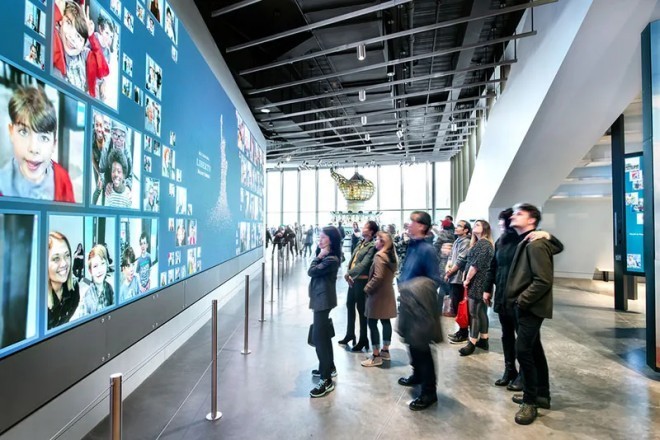
1.1). 功能描述:
清晰度高:想象一下,你站在一幅巨幅油画前,可以清晰地看到每一笔的细节。小间距LED显示屏就像这幅油画,它的像素点之间的距离非常小,因此可以呈现出极其细腻清晰的画面。
高对比度:对比度就像是画面的“层次感”,高对比度意味着画面黑白分明,色彩更加鲜明立体,就像你在阳光下看到的蓝天白云,那么清晰,那么立体。
近距离观看效果好:如果你站得很近去观看一幅画,你会发现画上的细节更加丰富。同样,在近距离观看时,小间距LED显示屏依然能保持画面的清晰度和细腻度,让你仿佛置身于画中。
1.2).适用场景:
高端展厅:比如珠宝展、艺术品展等,需要展示精美的产品或者艺术品,小间距LED显示屏可以完美呈现产品的每一个细节。
艺术品展示:当想要展示一幅精美的画作或者雕塑时,小间距LED显示屏可以作为背景或者辅助显示工具,增强艺术品的吸引力。
细节展示区:在需要展示产品细节或者工艺流程的区域,小间距LED显示屏可以清晰的展示每一个步骤和细节,让观众更加深入的了解产品。
2). 租赁LED显示屏:灵活便捷,适合临时展览
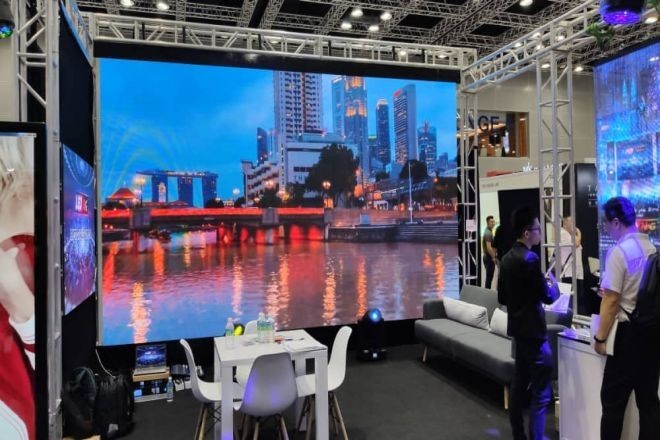
2.1)。特征:
重量轻、安装简便:租赁LED显示屏就像一个可以随时拆卸的“大箱子”,重量轻、结构紧凑,安装非常简单快捷。
便于运输和重复使用:由于采用模块化设计,租赁LED显示屏可以轻松拆卸、运输和储存。而且使用寿命长,可以多次重复使用,非常经济。
2.2).适用场景:
临时展览:针对文化节、艺术节、产品发布会等短期展览,租赁LED屏可以灵活应对各种临时需求。
活动展览:在各类大型活动及展览会中,租赁LED屏可以作为信息显示、广告播放的重要工具,吸引观众的注意力。
多场馆巡回展览:如果您的展览需要在多个场馆巡回展出,租赁LED屏的便携性和可重复使用性将是您的最佳选择。
3). LED透明屏:无限创意,增强空间通透感
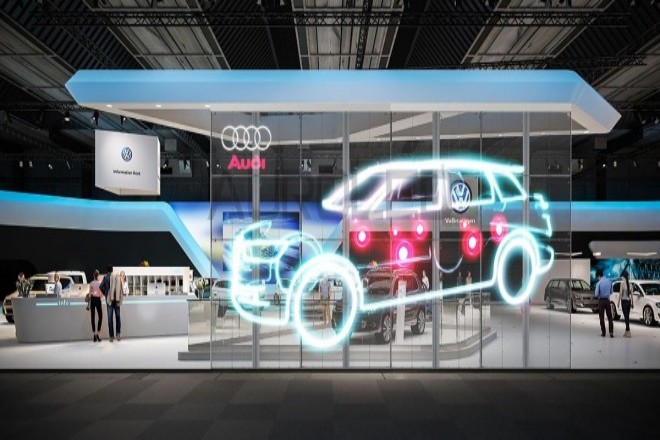
3.1)。特征:
透明度高:透明LED屏就像一块透明的玻璃,但可以播放视频和图像,其网格状结构允许光线穿透,但不影响空间的透明度。
创意展示效果好:透明LED屏可以与背景环境进行创意展示,如将视频与实物展品相结合,营造出令人惊叹的视觉效果。
3.2).适用场景:
橱窗展示:在零售商店或品牌店中,透明LED显示屏可以作为橱窗展示的一部分,以吸引顾客的注意力并提升品牌形象。
科技馆互动体验区:在科技馆中,透明LED显示屏可以作为互动体验的一部分,让观众在互动中学习科学知识。
零售门店:在门店的关键位置安装透明LED显示屏,可以动态显示产品广告、促销信息或品牌故事,提升顾客的购买欲望和品牌认知。
4). 灵活的曲面LED显示屏:形态多样,增强视觉冲击力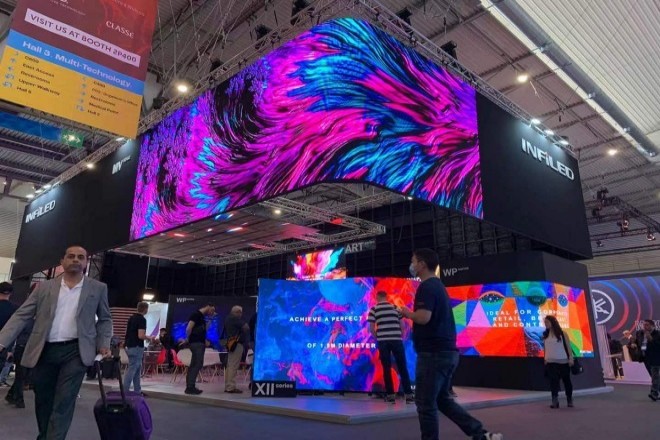
4.1). 功能描述:
形态灵活:柔性/曲面LED显示屏就像一块可以随意弯曲的“布”,可以根据您的需求定制成各种形状和尺寸。
根据空间定制形状:在展厅中,您可能需要一块可以贴合墙面或柱子的显示屏。柔性/曲面LED显示屏可以根据您的需求进行定制,完美融入空间。
增强视觉冲击力:独特的形式和视觉效果能吸引观众的注意力,使您的展览更加引人注目。
4.2).适用场景:
创意展厅:例如科技馆、美术馆等需要展示创意、设计理念的展厅,柔性/曲面LED显示屏可成为展示的亮点。
主题公园:在主题公园中,柔性/曲面LED显示屏可以作为装饰或信息展示工具,增加游客的互动性和趣味性。
未来科技展示区:在未来科技展示区中,柔性/曲面LED显示屏可以作为展示未来科技产品或概念的重要工具,营造出科幻、前卫的展示氛围。
3、LED显示屏关键性能指标的考虑
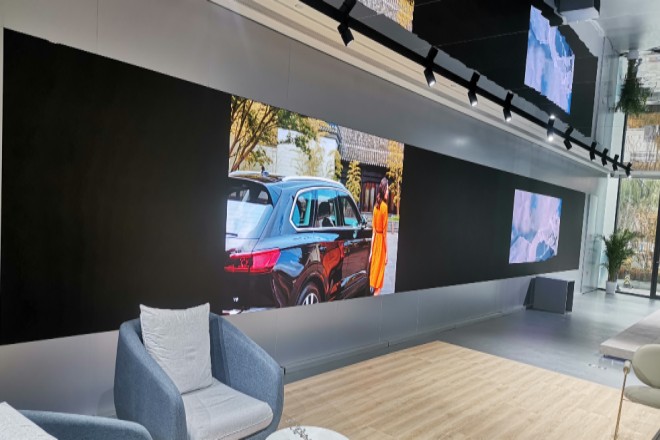
在选择LED显示屏时,关键性能指标是保证显示效果和质量的重要因素。下面就分辨率和像素密度、亮度和对比度、刷新率、可视角度四大关键性能指标进行详细考量:
1). 分辨率和像素密度
- 概念解释:
分辨率是指显示屏能够显示的水平和垂直像素数量,常见的分辨率有720p、1080p、4K等,分辨率越高,显示屏能够显示的像素越多,图像细节越丰富。
像素密度是指显示器在特定面积内可显示的像素数量,单位一般为每英寸像素数(PPI)。像素密度越高,相同面积内显示的细节越丰富,图像越清晰锐利。
- 对图像清晰度的影响:
分辨率和像素密度直接影响图像的清晰度,高分辨率、高像素密度的显示器可以呈现更多的细节和更丰富的色彩,使图像更加真实生动。
在展厅环境中,高分辨率、高像素密度的LED显示屏可以保证观众即便在近距离观看时也能看到清晰细腻的图像。
2). 亮度和对比度
- 亮度:
概念:亮度是指显示器发出的光的强度。
不同光环境要求:在明亮的环境下,如户外或光线充足的展厅,需要选择高亮度的显示屏,以保证图像清晰可见;在较暗的环境下,可以选择亮度适中的显示屏,以节省能源并减少眩光。
- 对比:
概念:对比度是指显示器所能显示的最亮部分与最暗部分之间的差别。高对比度可以呈现更多的细节和更深的黑色,使图像更加立体和生动。
色彩层次表现的重要性:高对比度可以增强色彩层次和立体感,使图像更加饱满逼真。在展厅环境中,高对比度的显示屏可以保证观众在各种光照条件下都能看到清晰逼真的图像。
3). 刷新率
概念:刷新率是指显示屏每秒重复显示画面的次数,单位是赫兹(Hz)。
对动态图像流畅度的影响:刷新率越高,画面显示越稳定流畅,视觉闪烁越少。在展厅环境中,特别是在显示动态内容(如视频、动画等)时,高刷新率LED显示屏可以提供更流畅、更自然的观看体验。
4). 可视角度
概念:可视角度是指观察者从正面观察时,能看到屏幕上内容的最大角度范围。
保证观众在各个角度都能看清楚:在展厅环境中,观众可能会从不同的角度观看显示屏,因此需要选择视角较大的LED显示屏,保证观众在各个角度都能看到清晰、无失真的图像。
一般来说,LED显示屏的视角至少应在120度以上,才能保证良好的观看效果。
结论
通过深入了解、比较分析,为展厅选择出性价比最高、效果最好的LED显示屏。
值得注意的是,随着技术的不断进步和市场的不断发展,LED显示屏的性能和价格也在不断发生变化。
因此,在选择显示器的时候,不仅要关注当前的市场行情,更要关注未来的发展趋势,确保所选的显示器能够满足展厅长期运营的需要。
最后,如果您想了解更多关于LED显示屏的知识, 请与我们联系。
